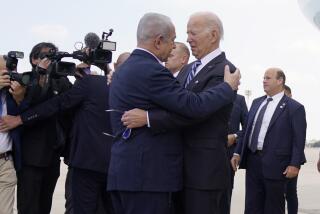Arms and Politics
- Share via
Since they started their series of summit meetings, President Reagan and Soviet General Secretary Mikhail S. Gorbachev have resurrected an international fact of life: Arms and arms control serve the same master--politics. Politicians--or, in the striped-pants version, statesmen--not generals or strategic analysts, decide how many weapons a nation needs. This is not exactly revelation. The generals in 1961 wanted 10,000 Minuteman missiles. John F. Kennedy let them have 1,000.
The technicians produced any number of reasons why the dismantling of medium-range missiles in and around Europe now under way would lead to catastrophe, but the politicians prevailed. The next step in arms control, slashing the number of intercontinental nuclear weapons by 40% or so, is more complicated and thus a better playing field for technicians who think that cutting the supply of big missiles is also a bad idea.
Dismantling some of the more than 10,000 nuclear missiles that each superpower has at hand is further complicated by events having to do with missile defense, not missile offense. Bargaining in Geneva between U.S. and Soviet delegations is in check largely because of a 1972 treaty, the ABM agreement, that limits deployment and testing of systems designed to destroy missiles before they reach their targets.
People deeply involved in the President’s “Star Wars” program would be perfectly happy without an ABM treaty so that they would not have to worry about whether some of the tests of their missile-defense ideas would violate the agreement. The Soviets, who are doing research of their own on defenses, want rigid adherence to the ABM treaty on the theory that it would slow Star Wars.
The Soviets are not always comfortable talking about the ABM treaty. They have an unfinished 30-story radar tower at Krasnoyarsk in the south central part of the country that clearly violates a treaty rule on where such radar systems can be located. Hard-liners in Washington want to declare the radar a “material breach,” the worst of the treaty’s categories of violation, tear up the ABM treaty and get on with Star Wars testing. Even the most vocal arms-control advocates agree that the violation cannot be blinked away. But they want to keep trying to talk the Soviets into destroying the radar at the same time that they try to reach agreement on major missile reductions.
It is a serious problem, but it is not insoluble, and it also is a minor point compared with the basic political decision that led to talks in Geneva in the first place. That decision said in effect that, like any good soldier, the Pentagon had squirreled away far more weapons than it was likely ever to need, just to be on the safe side.
In the right mixture, starting with the big missiles that make both sides nervous about their possible use in a preemptive strike, superpower arsenals can be cut by far more than half and still leave enough weapons to deter aggression.
Either candidate for President may be strongly tempted along the line to drag Krasnoyarsk into the campaign, perhaps to show how tough he can be with the Soviets.
That would mean gambling with the basic political decision to start emptying the quivers in both countries of the most destructive weapons ever made by man. It would not be a smart gamble.
More to Read
Sign up for Essential California
The most important California stories and recommendations in your inbox every morning.
You may occasionally receive promotional content from the Los Angeles Times.













